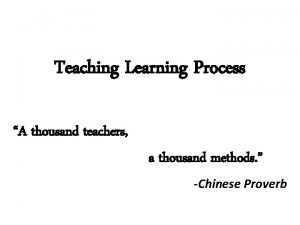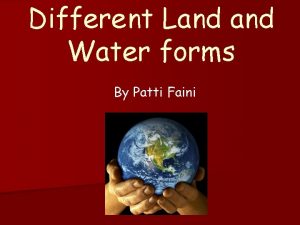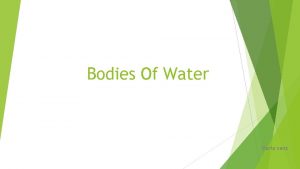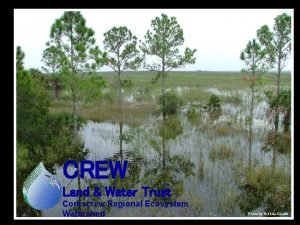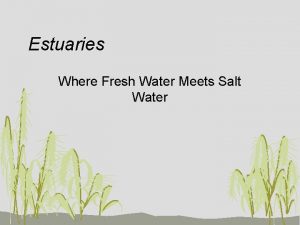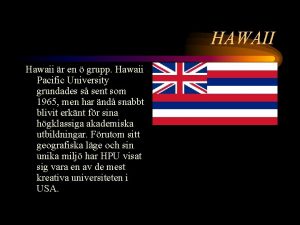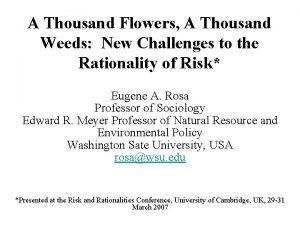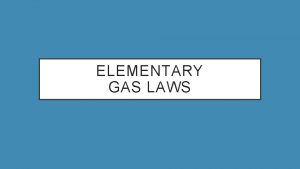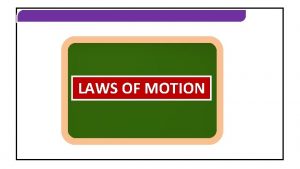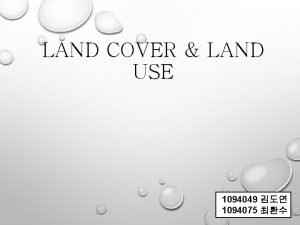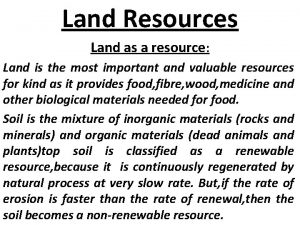Land Water Laws in Hawaii Hawaii Thousand Friends


























- Slides: 26

Land Water Laws in Hawai`i Hawaii Thousand Friends Donna Wong, Executive Director

The Constitutional Basis of The Public Trust Doctrine State of Hawai`i Constitution, Article Xl, Section 1: CONSERVATION AND DEVELOPMENT OF RESOURCES: For the benefit of present and future generations, the State and its political subdivisions shall conserve and protect Hawaii’s natural beauty and all natural resources, including land, water, air, minerals and energy sources, and shall promote the development and utilization of these resources in a manner consistent with their conservation and in furtherance of the self-sufficiency of the State. All public natural resources are held in trust by the State for the benefit of the people.

The Constitutional Basis of Rights to a Healthy Environment State of Hawai’i Constitution, Article Xl, Section 9: Each person has the right to a clean and healthful environment, as defined by laws relating to environmental quality, including control of pollution and conservation, protection and enhancement of natural resources. Any person may enforce this right against any party, public or private, through appropriate legal proceedings, subject to reasonable limitations and regulation as provided by law.

The Constitutional Basis of Agricultural Lands Protection State of Hawai`i Constitution, Article XL, Section 3: The State shall conserve and protect agricultural lands, promote diversified agriculture, increase agricultural self-sufficiency and assure the availability of agriculturally suitable lands. The legislature shall provide standards and criteria to accomplish the foregoing. Lands identified by the State, as important agricultural lands needed to fulfill the purposes above shall not be reclassified by the State or rezoned by its political subdivisions without meeting the standards and criteria established by the legislature and approved by a two-thirds vote of the body responsible for the reclassification or rezoning action.

STATE LAND USE LAW (HRS 205) Purpose of the Law In 1961, the Hawaii State Legislature determined that a lack of adequate controls had caused the development of Hawaii’s limited and valuable land for short-term gain for the few while resulting in long-term loss to the income and growth potential of our State’s economy. Development of scattered subdivisions, creating expensive yet reduced public services, and the conversion of prime agricultural land to residential use, were key reasons for establishing the statewide zoning system. To administer the law, the Legislature established the Land Use Commission. It is responsible for preserving and protecting Hawaii’s lands and encouraging uses to which lands are best suited.

STATE LAND USE LAW (HRS 205) How it Works The Law classifies all lands in Hawai`i into four districts: URBAN – administered by counties CONSERVATION – administered by state Board of Land Natural Resources RURAL – jurisdiction shared by LUC and counties AGRICULTURAL – city and state jurisdiction unclear No amendment to a land use boundary shall be adopted unless it conforms to the State Plan. (§ 226)

Maui County Land Use Designations

HAWAI`I STATE PLANNING ACT - HRS 226 1978 The stated goal was to slow development and shape future growth. It attempted to create a policy framework encompassing the economy, the environment, infrastructure, housing, health systems, social services, individual rights and well-being, public safety, and government. It aimed to involve broad public support in setting goals and encouraging more conscious, informed and transparent tradeoffs among conflicting goals. Implementation of the law was assigned to Functional Plans, which were developed by stakeholder groups and approved by the Legislature. Momentum behind this initiative floundered on a finding that the Functional Plans lacked the force of law. The State Plan was abandoned when George R. Ariyoshi left office in 1986.

LAND USE COMMISSION Composition Commissioners are unpaid volunteers and are supposed to represent a cross-section of the community. Nine members appointed by Governor and confirmed by Senate One member appointed from each of four counties Five at-large members “One member shall have substantial experience or expertise in traditional Hawaiian land usage and knowledge of cultural land practices. ”

LAND USE COMMISSION Role Ensure State concerns are addressed in land use decisions Set boundaries in response to petitions from private landowners, developers, State and County agencies Act on requests for special use permits in the Agricultural and Rural Districts

LAND USE COMMISSION District Boundary Amendment Procedures ✔State, County or private owner may petition for a boundary review ✔Commission holds hearing in 60 -180 day window ✔Commission approves, approves conditionally, or denies ✔Conditions “run with the land, ” binding the present and future until changed ✔Decisions on Conservation land require an EIS ✔Decisions require six of nine commissioners

LAND USE COMMISSION A Quasi-Judicial Process ✔Gives “due process” to those most directly affected. ✔“Parties” may represent themselves or be represented by attorneys or other ✔An “intervener” may present witnesses, cross-examine opposing witnesses, and appeal decisions. An intervener may appeal commission decisions to the Hawai`i Supreme Court.

LAND USE COMMISSION Decision-Making Criteria ✓Must conform to Hawaii State Plan (HRS Chapter 226) ✓Must weigh County General Plans and, if applicable, the State Coastal Zone Management Law (HRS Chapter 205 A) ✓Must be cognizant of impacts on : natural systems or habitats; cultural, historical or natural resources; other natural resources relevant to Hawaii’s economy and resources particularly agricultural; commitment of state funds and resources; economic development; and provision for housing opportunities for all income groups, particularly the low, low-moderate, and gap groups.

LAND USE COMMISSION Exceptions from the Law FIFTEEN ACRE RULE: Petitioner may apply directly to County unless land is in Conservation District (1985 amendment) AFFORDABLE HOUSING FAST-TRACK are decided in 45 days SPECIAL USE PERMITS: “unusual and reasonable” uses of more than 15 acres can be heard by counties, forcing an LUC decision in 45 days after County proceeding

LAND USE COMMISSION Enforcement of designations The lead planning officer or agency of each county is charged with enforcing the land use classification of districts and the condition of agricultural lands (205 -4. 5), and is also charged with reporting all violations of boundary designations to the LUC

LAND USE COMMISSION Five-year Boundary Review By law, the LUC is supposed to review the classification of all lands every five years. However, the last five-year review was in 1992.

“Important Agricultural Lands” The so-called Important Agricultural Lands act of 2005 (Act 183) is probably the single largest loophole in the protection of agricultural land, contrary to its statement of purpose. Under HRS 205 -45 a landowner may petition the LUC for a declaratory order to re-designate land as Important Agricultural Land in return for re-designating 15% of that land as Urban. The issue never addressed in court is whether the IAL violates the constitutional protection of AGRICULTURAL LAND.

Today’s LUC in Action – A Worst Case Example

Coastal Zone Management Law – 205 a ✓Pursuant to the Federal CZM Act of 1972, the State CZM was enacted in 1977 to treat the shore-line area as a unique ecosystem. CZM is a complex act with potentially far-reaching mauka-makai possibilities. ✓Current projects include: Climate Change Adaptation Ocean Resources Management Plan Ocean Research Reserve program ✓CZM theoretically includes all islands and waters seaward 3 miles. ✓It creates a State shoreline setback zone of a minimum of 20 feet from the high water mark, and a county zone, typically to the nearest major roadway. ✓The Office of State Planning is responsible for CZM. Counties can receive administrative funds from the Federal government but the City and County of Honolulu has opted out.

CZM - Special Management Areas, Maui County

STATE WATER CODE - 1987 Declares all water of Hawaii a public trust Mandates “protection of traditional and customary Hawaiian rights, the protection and procreation of fish and wildlife, the maintenance of proper ecological balance and scenic beauty, and the preservation and enhancement of waters for municipal uses. ” Prohibits discharge of any substance into the water unless it is treated to render it harmless to water quality

Historic Preservation Law- HRS 6 E Pursuant to the State Constitution’s protection of historic and cultural sites, this legislative act declares that the State shall “provide leadership in preserving, restoring and maintaining historic and cultural property, to ensure the administration of such historic and cultural property in a spirit of stewardship and trusteeship for future generations…”

ADDITIONAL LAND USE PLANNING LAWS Office of State Planning – broad functions Quality Growth Policy – HRS 223 Cave Protection – HRS 6 D Agribusiness Development Corporation –HRS 163 D Public Land Management – HRS 171 Oahu Land Development – HRS 206 County Organization and Administration - HRS 46 State Environmental Policy – HRS 344

Hawaii Community Development Authority Passed in 1976 when the legislature determined that many areas of the State are substantially undeveloped, blighted, or economically depressed, and in need of renewal, renovation, or improvement Overseen by a Governor appointed board (HCDA) The legislature has the power to create a Hawaii Community Development District on any island

Kaka’ako Under State Control Hawai`i Community Development District

HCDA Permits for Kaka`ako in 3 D
 Water and water and water water
Water and water and water water A thousand teachers a thousand methods explanation
A thousand teachers a thousand methods explanation Tenth thousandth
Tenth thousandth Disciplinal approach advantages
Disciplinal approach advantages Little friends may prove great friends
Little friends may prove great friends Facts about montesquieu
Facts about montesquieu An area of land largely enclosed by higher land
An area of land largely enclosed by higher land Identify the landform
Identify the landform Land water and air pollution
Land water and air pollution Land water and air pollution
Land water and air pollution Freshwater
Freshwater Types of water forms
Types of water forms A high point of land extending into water
A high point of land extending into water Euphors
Euphors Water distribution on earth
Water distribution on earth Specific heat of water and land
Specific heat of water and land Corkscrew regional ecosystem watershed
Corkscrew regional ecosystem watershed School water audit
School water audit Dwafwa
Dwafwa Water o water
Water o water Estimating products of fractions
Estimating products of fractions Class 8 english chapter 7 water water everywhere
Class 8 english chapter 7 water water everywhere Water heat exchanger
Water heat exchanger Fresh water meets salt water
Fresh water meets salt water Warm water rises in a lake. cold water descends.
Warm water rises in a lake. cold water descends. Clil water
Clil water Important water resources
Important water resources

